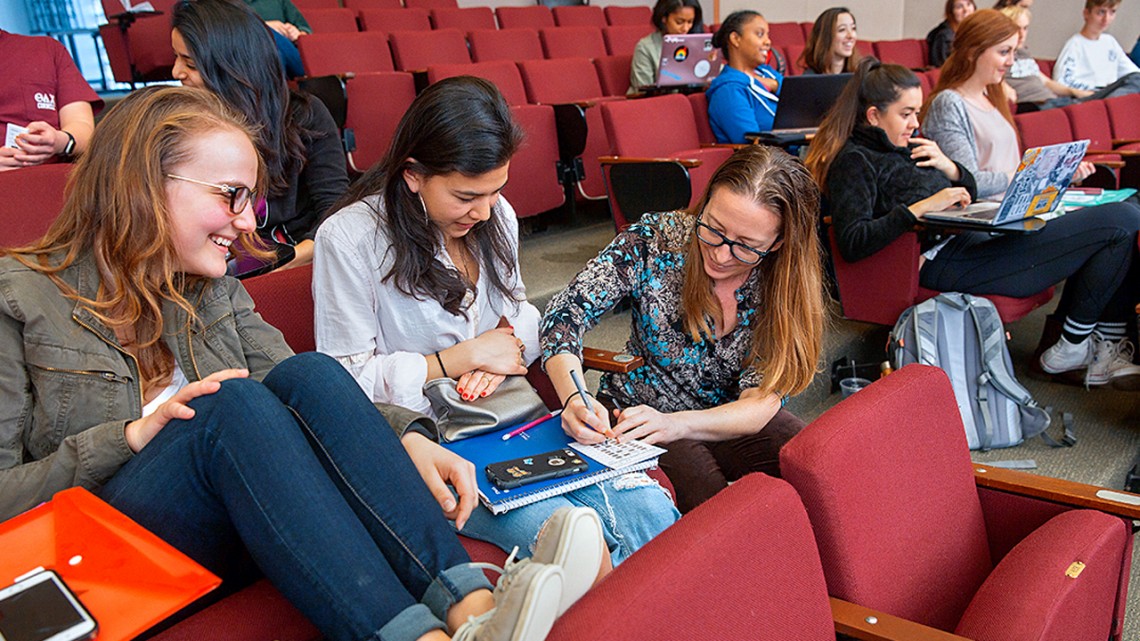
Students are shown in a small-group setting in Kelly Zamudio's gateway course Introduction to Evolutionary Biology and Diversity. The course is part of the Active Learning Initiative in the College of Arts and Sciences.
Study addresses low female participation in STEM classrooms
By Linda B. Glaser
A new study demonstrates that increasing class size has the largest negative impact on female participation in science, technology, engineering and mathematics (STEM) classrooms, and offers insights on ways to change the trend.
Using data obtained from 44 science courses across multiple institutions – including Cornell, the University of Minnesota, Bethel University and American University in Cairo – the team calculated female participation from more than 5,300 interactions between instructors and students over a two-year period. Their research revealed that large classes begin to negatively impact students when they reach enrollments over 120 students.
The study, “Smaller Classes Promote Equitable Student Participation in STEM,” published July 24 in Bioscience.
“We show that class size has the largest impact on female participation, with smaller classes leading to more equitable participation. We also found that women are most likely to participate after small-group discussions when instructors use diverse teaching strategies,” said lead author Cissy Ballen, a former postdoctoral researcher in the Department of Ecology and Evolutionary Biology and now an assistant professor at Auburn University. “We hope these results encourage instructors to be proactive in their classrooms with respect to these inequities.”
The results call for a halt on the continued expansion of large introductory courses and highlight the importance of studying factors that either promote or counter equity. For example, many evidence-based active-learning techniques appear to work by making large classes function like smaller classes.
Study co-author Abby Drake, senior lecturer in ecology and evolutionary biology, has implemented Team-Based Learning in the large gateway course Introduction to Evolutionary Biology and Diversity, where students work together in small teams.
“This reduces the faculty-to-student ratio from more than 1:200 to 1:50,” Drake said. “We have seen a significant decrease in the number of students who don’t succeed. Before the use of active learning and team-based learning, we would have upwards of 10 to 15 students failing or getting Ds. For the last three semesters, only two or three students have failed or received Ds. We are creating a small classroom climate within our large class and it is fostering student success.”
The gateway course is part of the Active Learning Initiative in the College of Arts and Sciences.
It has long been known that large classes, such as gateway classes, can be especially challenging for certain demographic groups, such as first-generation students, underrepresented minorities and women, noted study co-author Kelly Zamudio, the Goldwin Smith Professor of Ecology and Evolutionary Biology in the College of Arts and Sciences.
“What we show here,” Zamudio said, “is that the deficit is not with those students, but rather with the classroom. If you want participation by everyone, then the classroom has to be an equal, open arena for everyone.”
Stepfanie M. Aguillon, a Ph.D. candidate in field of ecology and evolutionary biology, explained that because participation in class itself is preparing students to be scientists, “it’s really important that we figure out what promotes more equitable participation by women.”
Zamudio noted that the study focused on gender and that future studies are needed to investigate other axes of diversity. “Diversity in STEM in the future will depend on us all paying attention to these issues, not just in admissions and retention, but also in classroom climate,” she said.
Ballen added that participation has been linked to a number of student traits that can contribute to academic success, such as critical thinking skills, decreased anxiety and a higher sense of belonging in the classroom. “We realize that, ultimately, administrators and legislators must address the problems with large class sizes, and we hope this work can be part of that conversation,” Ballen said.
Renee Petipas, Ph.D. ’18, also contributed to the study, which received support from the National Science Foundation.
Linda B. Glaser is a staff writer for the College of Arts and Sciences; Carla Nelson, Auburn University, contributed to this story.
Media Contact
Get Cornell news delivered right to your inbox.
Subscribe
